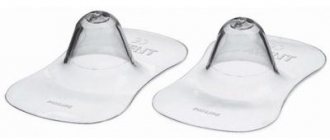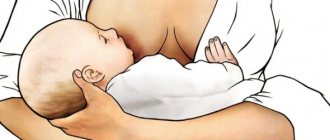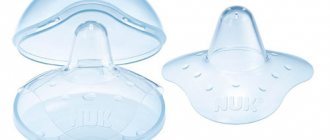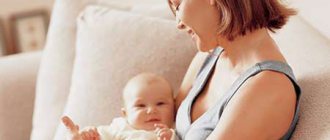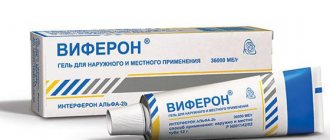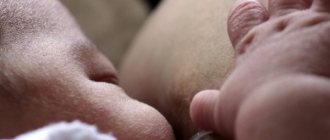Nipple shields are a real lifesaver for some breastfeeding women.
What are nursing pads?
Silicone breast pads are like funnels made of thin and flexible transparent material, they are put on a woman’s nipples and help the newborn baby to latch onto the nipple and get enough of it more easily. In this case, the woman does not experience pain .
One of the options that can be seen on the shelves of our pharmacies are Medela feeding pads.
What are nursing pads?
Pads from Medela, made in the form of flexible silicone funnels with holes at the end, are designed for comfortable feeding, which creates the closest possible contact between mother and child.
Made of thin transparent polymer, they take into account the structure of the female breast, its delicate skin, and have a variety of configurations. But the most common is the round shape, which suits most women. All female feeding aids should be considered as an additional tool for short-term use.
Advantages of Medela onlays
Medela - breastfeeding pads, which are produced by a well-known Swiss company, are produced for women who have problems feeding their baby.
Some mothers after giving birth complain about nipples that are not prominent enough. This prevents the baby from fully sucking the breast. Constant training of the mammary gland in the form of rubbing before feeding does not guarantee that they will not develop cracks and irritation.
The pads protect the female breast from the touch of the child’s tongue and saliva, which causes pain in the area of the cracks.
Some babies have a poorly developed sucking reflex. They constantly lose their breasts and try to invert the nipple. For these babies, assistive products help them receive adequate nutrition. A dense female nipple also causes discomfort for the baby when sucking. An overlay that softens the nipple and forms its correct shape provides easy access to breast milk.
Advantages:
- Comfortable because they are made of soft silicone, ultra-thin, odorless and tasteless.
- The material from which the products are made does not contain bisphenol A.
- The outer layer is waterproof but allows air permeability.
- Provide complete protection to female nipples, flat, elongated or cracked.
- Perfect fit to the chest. Due to their contoured design, reminiscent of the shape of a woman's breast, they create maximum skin-to-skin contact between baby and mother.
- Medela products are most popular among women with painful and inverted nipples. During feeding, they can stretch out, and the pads protect the woman from discomfort.
- They protect the female breast from injury during teething.
Medela has also developed special disposable breast pads that absorb secreted milk and prevent the appearance of wet circles around the nipples.
They protect clothing from nightly milk leakage, trap it inside the lining, like a baby's diaper, and keep nipples dry.
They have adhesive tape on the back of the pad that you can use to attach them to your bra. Disposable pads are made of special comfortable and moisture-absorbing materials.
Which overlays to choose?
To get the most out of using breast pads, you need to have a good understanding of how to choose them correctly. A high-quality and expensive thing is not the key to solving all problems associated with lactation.
What to look for when choosing:
- Correct shape and size (you need to focus on the width of the nipple);
- Full placement of the nipple inside the silicone (latex) product;
- Filling the entire space of the pad with the nipple;
- Correct size and number of holes;
- No discomfort during feeding and a feeling of milk flow.
You can choose the right overlay by using several models, companies, materials, and choosing the most suitable one.
Flaws
Despite all the positive aspects, pads can injure the nipple. This happens if the wrong size was chosen or they were used incorrectly.
Some women experience a decrease in milk supply after using pads. This happens because the nipple is poorly stimulated by the baby. When using the product, you should carefully monitor your baby's weight gain. Often the feeding process in this case ends prematurely.
Using breast shields increases the risk of clogged milk ducts and mastitis. This occurs due to incomplete suction of milk by the baby.
Some children get used to breastfeeding using breastfeeding attachments, and then completely abandon natural feeding. Therefore, mothers are forced to resort to bottle feeding. Continued use of the product may cause your baby to develop the habit of chewing the nipple instead of suctioning.
The biggest potential risk with breast pads is bacterial growth. Microorganisms thrive in warm, moist environments, so breast pads can become a breeding ground if not cared for properly.
Constant wetness of the nipples should be avoided, which is especially important if the skin around them is damaged. This can lead to mastitis, an infection in the milk ducts.
Warm, moist environments also encourage fungal growth. One particularly unpleasant symptom for nursing mothers is a fungus called candida, which stimulates the development of thrush. The disease can occur in both the baby's mouth and the mother's nipple, causing painful symptoms such as itching and flaking.
Medela breastfeeding shields, which, like products from other manufacturers, can irritate the skin of the nipple in some women. To prevent this, you should use nipple creams produced by Medela.
Advantages and disadvantages
Pros of silicone and latex nipple covers:
- teach the child to suck the breast correctly (when the baby did not have the opportunity to suck the breast for a long time after birth);
- make it possible to supplement the baby's breastfeeding (they use a tube from the supplementary feeding system when the baby refuses to latch on to the breast);
- stretch and maintain the elongated shape of a non-standard nipple when the child pauses between sucks;
- protects the mammary gland from injury by a child (for example, if he refuses to feed);
- are able to increase stimulation of the nipple during sucking if the child does it sluggishly.
Despite all the advantages, overlays have their disadvantages:
- spontaneously used by mothers as a way to solve a medical problem, instead of qualified consultation and assistance from a doctor;
- lead to postponing the solution to the problem in a “long box”;
- exacerbate the original problem;
- can disrupt lactation by inadequate milk secretion (production per suckling is reduced by more than 50%), impaired weight gain of the child;
- provoke too early cessation of lactation;
- disrupt the configuration of the nipple in the baby’s mouth during feeding (the normal shape is a widened nipple at the base);
- reduce the production of the hormone oxytocin while feeding the baby;
- make it difficult to express milk;
- lead to disruption of the sucking mechanism. The baby suckles quickly and intensely, which leads to long pauses. A similar sucking mechanism is observed during the decline of lactation and, over time, reduces the production of milk by the gland;
- if used incorrectly, they can compress the areola and nipple, which causes abrasions, pain, damage to the skin and internal tissues of the mammary gland;
- the use of pads increases the duration of feeding;
- exhaust the child. The baby gets tired from prolonged sucking and falls asleep half-starved;
- milk may leak under the pad due to which the baby does not get enough to eat;
- the child develops an addiction to the pad, which is why he may refuse to breastfeed without devices;
- during sucking, air is swallowed more often - the child may develop flatulence, colic, and frequent regurgitation;
- after refusing to use pads, the likelihood of damage to the mammary gland when the baby is applied to it increases significantly, since he may not suck the gland, but begin to chew it;
- the devices are inconvenient to use at night or while walking;
- an insufficiently sterilized pad is a source of infection;
- use increases the risk of developing candidiasis (fungal infection) of the breast.
Indications for use
When overlays are needed:
- In case of unbearable pain in the nipple area, which is often present in primiparous women. Injuries around the nipples, pain, and the baby’s reluctance to suckle are common reasons for switching to artificial feeding. In this case, gaskets become indispensable.
Proper attachment to the breast will help avoid pain in the nipples during feeding - When feeding premature babies who cannot fully feed on milk, the pads can ensure the feeding process. In this case, children will receive mother's milk in full.
- Children with atypical sucking technique . These may be physical defects in the form of a short lingual frenulum, which prevents the child from latching onto the nipple correctly.
- In case of transition of a child from artificial to breastfeeding . If after birth the child was on artificial nutrition for medical reasons, and then he was shown switching to breastfeeding. In this case, the overlay will help the mother quickly restore natural function.
- Discrepancy between the size of the female nipple and the baby's mouth.
- Babies who fall asleep almost immediately at the breast.
How to wean your baby
Refusal of pads can be stressful for a nursing mother and baby. To make this process as painless as possible, you should, if possible, reduce the period of use.
Weaning rules:
- Try breastfeeding at night when your baby is sleeping or in the morning, right after he wakes up.
- Start feeding as usual with the pad on. As soon as the baby is carried away by the process, quickly remove it so that he does not notice the substitution.
- Gradually make the product smaller by cutting off the material at the top so that the baby gets used to the juice in his mouth. After some time, it will be possible to completely remove this product.
Some children become so accustomed to drinking milk through a silicone device that they categorically refuse to take their mother's breast. A woman should not despair, the situation can be corrected, but she must be patient.
Helpful Tips:
- First of all, a nursing mother must establish emotional contact with the baby. To do this, you need to be nearby all the time in a good mood, play more, carry in your arms, you can try sleeping together.
- As soon as the baby shows signs of anxiety, the breast should be offered. If he refuses, pet him, but do not give him a pacifier, bottle or breast with a pad.
- If the baby does not get enough to eat, you need to supplement him with breast milk from a spoon or syringe.
Most often, returning to regular breastfeeding after using breastfeeding is difficult and can take several weeks. As experts note, the difficulties of refusing them far exceed the problems that can be solved with the help of this product. To avoid such problems, the feeding product should be used in emergency situations and for no more than 3-4 days.
Contraindications
Contraindications will be large cracks in the nipple area with signs of suppuration, general diseases of the mother, in which doctors do not recommend breastfeeding. Do not use for painful sensations in the chest, swelling of the mammary glands, or lactostasis. In case of development of a bacterial infection of the breast, mastitis, it is also recommended to abandon the pads.
The use of feeding attachments can have negative consequences:
- The child gets used to the nozzle and, as a result, refuses natural feeding.
- Changing the sucking technique: capturing milk only due to the vacuum created, without applying excessive force, increased clenching of the jaws by the child.
- Low breast stimulation, which affects milk production.
- Psychological addiction of a woman to the nozzle and fear of switching to the natural way of sucking.
How to choose a product? Types and sizes
Regardless of the type of product, there are several features that should be taken into account when purchasing:
- Form . It should anatomically match the shape of the breast.
- Comfort . These little pads are used all day, so they need to be comfortable and fit properly.
- Thickness _ They should be thin so that the child feels them less.
- Availability of number of holes . Ideally there should be no more than 4.
Sizing chart:
| International pad size | Compliance with the female breast (in a tense state of the nipple) |
| S (16 mm) | Minimum size, corresponds to nipple diameter ‹ 1 cm |
| M (20 mm) | Size medium, corresponds to nipple diameter ꞊ 1 cm |
| L (24 mm) | Maximum size, corresponds to nipple diameter › 1 cm |
The best way to choose is to try on the product, but since this is difficult to do, you should accurately measure the size of the nipple in a tense state. The shield should fit easily and follow the shape of the nipple. When feeding a child, you should pay attention to ensure that the nipple completely fills the entire cavity inside the product.
Medela breastfeeding shields come in different sizes
If there is free space between the shield and the nipple or it puts pressure on the breast, then the size is chosen incorrectly. An important criterion when choosing a medical device is the feeling of thoracic congestion during feeding. This means that the selected product is quite thin and fits in size.
Why do you need pads when breastfeeding?
Unless the mother has difficulty leaking excess fluid, do not use inserts. If women are faced with excessive leakage, then bra pads will become the main assistants, eliminating the difficulties.
It is important to choose the right gaskets; you should not skimp or use them not according to the instructions, otherwise the cracks will not dry out as needed, and the content of harmful bacteria in the milk will increase. When choosing, the material of production should be taken into account - cheap materials will cause allergies or harm the breasts.
Materials
Modern young nursing mothers choose pads from Medela because they are made from thin material - silicone. They are more comfortable and pleasant to the touch. The shape of the product is convenient for both mother and child.
Silicone ones completely follow the contours of a woman’s breast; at the top there is a special cutout into which the baby rests his nose when feeding. This is done so that the child receives olfactory and tactile contact with the mother. There are small holes in the middle of the funnel for normal flow of milk.
Most Popular Brands
The most popular manufacturing companies make breast pads from silicone or latex, but each model has its own characteristics. They also differ in cost - from 250 to 2050 rubles.
The most popular brands: Avent, Medela, Ardo, Chicco.
Philips Avent
This pad is made of very thin silicone, which does not have any taste or aroma. Philips Avent offers two models, which are characterized by different sizes:
- small Avent pads;
- regular Avent pads.
Philips Avent thin silicone solves two problems at once. For example, the baby does not come into contact with the damaged skin of the nipple during feeding.
At the same time, the baby feels all the warmth of the mother, maintaining close bodily contact with her. Avent is one of the leaders in the global market.
Medela
The Medela breast pad is available in several versions, differing in shape:
- size S - useful when feeding a child born prematurely, or with a nipple width less than a centimeter;
- size M – the width of the tense nipple is one centimeter;
- size L – the width of the tense nipple is more than a centimeter.
Such Medela devices are made from the finest silicone, which does not have a pronounced taste or smell.
Ardo
This protective device is of high quality due to its material, flexibility and small parameters.
It is intended for short-term use, so it does not deprive the child of natural interaction with the mother.
M/L sizes help you choose the product that is most suitable for the mother's breast and child. In addition, women will be able to purchase an attachment based on its cost.
Chicco
The manufacturer also produces two versions of medical devices: large and small. These breast pads are made of natural latex, which reliably protects damaged papillae and reduces pain.
The advantage of Chicco is the small container in which the “caps” are stored. The disadvantage is the use of latex for production, which is considered a more harmful material than silicone.
Set contents
Medela is a Swiss company that produces ultra-absorbent pads for breastfeeding. They guarantee a woman dryness and comfort during night feedings and throughout the day. They meet all hygienic requirements.
Silicone products promote breast healing and also:
- help maintain good skin condition;
- form a protective cushion for sensitive or sore nipples;
- help cool the skin upon contact;
- sold in sterile individual packages;
- non-toxic and does not contain preservatives.
Medela Contact pads are available in pharmacies and specialized children's departments in the following configuration: 2 pads in a special container designed for storage.
How to use the pads?
Medela are breastfeeding pads that should be used only for their intended purpose, and only for one child. Before use, you should check the tightness of the case and the presence of damage to the product itself. You shouldn’t start using pads “just in case.” If the baby is eating well and gaining weight, then regular breastfeeding will be of great benefit.
When feeding a child using pads, you should gradually wean him off them. The best time for breastfeeding is after the baby is asleep, when he is less likely to be capricious about this. You can teach yourself to suck milk without silicone devices in another way.
Every day, cut a small piece from the end of the lining, placing pieces of fabric inside. This way, the baby will gradually understand that sucking is much better without feeling the taste of silicone.
Putting on
How to put on the silicone assistant correctly:
- Wash your hands before putting on.
- There is no need to wash your breasts before feeding; you just need to wipe them with a damp cloth. Soap and alcohol solution should not be used, this dries the skin, removes fat that is secreted by the tubercles on the areolas, and contributes to the appearance of dryness, irritation, and subsequently cracks.
- Take the overlay with both hands so that the cutout points up, and turn it slightly inward, like a hat.
- Place it on the nipple and press tightly.
- Make sure that the nipple is completely inserted into the shield; it should also cover the brown breast areola. The cut should match the baby's nose, as it is intended for tactile communication between baby and mother.
Feeding
The nipple enclosed in the nozzle should be passed over the baby's lips so that he opens his mouth more fully. Then, pointing the tip of the nipple towards the palate, place the breast deeply into the baby's mouth. It should be noted that when feeding, the baby should grasp not only the nipple, but also the areola with his mouth.
During the process of sucking milk, you should monitor so that the product does not slip off the breast. The position of the nozzle should be changed, since the filling of the nipple with breast milk is different at the beginning and end of feeding.
When feeding outside, you should hold the pad with two fingers, your middle and index fingers. An indicator of proper feeding is weight gain, frequency of bowel movements and urination of the child.
Removal
Removing the chest pad is easy; you only need to turn it inside out a little. Fresh breast milk helps heal cracks, so after feeding you can rub a few drops into your breasts. Then gently pat your nipples dry with a soft towel and let them dry.
From the experience of nursing mothers: reviews
They came in handy for me in the first 5-6 days, when the cracks were the smallest Aventov size (and even then they turned out to be large for me). It didn't hurt that much. But you can’t get carried away with them, because... the baby will get used to them, that’s what the breastfeeding consultant told me. It is inconvenient to sterilize and wash, it takes time.
Ginger
https://www.babyplan.ru/forums/topic/9352-nakladki-na-grud-dlya-kormleniya/
I also used Avent overlays for about 3 weeks from the maternity hospital, I had both large and small ones. In the maternity hospital, my nipples were very cracked, it was terrible. But everything healed quickly with them. Of course, you shouldn’t get carried away with them for a long time, otherwise problems will arise.
Nyuta
https://www.babyplan.ru/forums/topic/9352-nakladki-na-grud-dlya-kormleniya/
Girls, I use pads, but they don’t really help. My daughter has eaten away my nipples to such a state that she’s no longer Bepanten, nothing else helps. It’s uncomfortable with pads because of how she thinks. that it’s a pacifier, and starts to play, and generally sucks poorly. That’s why I put it in the pads only for the first 15 minutes, and then I give it a live nipple (it doesn’t hurt so much anymore). I’m ok with the shape of the nipple itself.
amaryllis
https://www.babyplan.ru/forums/topic/9352-nakladki-na-grud-dlya-kormleniya/
I needed them, but I had no idea that there were different sizes, and I had no choice - one box remained from Avent. The child sucks normally through them, but the shape of the butterfly is terrible, the wings of this butterfly were constantly bent and fit onto his nose.
Violchik
https://www.babyplan.ru/forums/topic/9352-nakladki-na-grud-dlya-kormleniya/
I used the Avent ones, I always held them with two fingers, but they didn’t hold on by themselves. At first I freaked out terribly, I imagined feeding in a different way in the pads. But the baby sucked normally in them and I adapted to feeding this way. I didn’t bother buying others, so I kept feeding them. What is inconvenient is inconvenient, you can’t say anything!
Evgescha
https://www.babyblog.ru/community/post/01medicina/1783931
Product care
Medela are breastfeeding pads that require special care. Cleanliness will help avoid the appearance of thrush in both mother and child, and will protect the pads from premature deterioration:
- Before use, the product should be sterilized. To do this, boil them for 2–3 minutes.
- During use, you can carry out sterilization. For this, it is better to use a steam sterilizer, which will do this using a gentle method and allow you to use the products for a long time. Disinfection can also be carried out in a microwave oven; to do this, place the pads in a bowl and add a little water.
- After use, rinse the product with clean water, no higher than 20°C, and then wash it with warm water and soap, no more than 30°C. Liquid baby soap is suitable for this, after which you should rinse and wipe well with a clean towel until it shines.
- After cleaning, the products are placed in a case until next use.
- Keep the product away from sunlight.
Manufacturers advise sterilizing before first use, and then using only water and soap. This will prevent the silicone from becoming rough. With thick pads it is more difficult for the baby to suck milk. And the thin ones produced by Medela allow you to quickly switch to breastfeeding.
When using products, you should pay attention to several points:
- Does the child receive adequate nutrition when feeding? It is necessary to monitor the filling of diapers daily. Children less than 5–6 months old should have at least 6 heavy and wet ones during the day. Daily bowel movements should be at least 3 times a day. Over the age of 6 months, stools should be less frequent, but just as abundant, soft and loose, and the baby should be weighed more often, once every 2 weeks.
- Pay attention to how often the baby swallows during feeding.
- A woman should listen to her feelings about whether her breasts have become soft after feeding. If this does not happen, then expressing milk will be necessary to prevent blockage of the milk ducts.
ChildbirthInfo
When a baby is born, especially if it is a woman’s first child, a whole list of new and unusual tasks arises that must be dealt with daily. With some you can “find a common language” faster, while others take a long time to get used to. Mothers usually have particular difficulties with breastfeeding, as they need to ensure that the baby is properly grasped so that both parties feel comfortable. To facilitate the feeding process and the difficulties that arise during it, special pads were created, which we will talk about in more detail.
The content of the article:
• Purpose of overlays • Varieties • Tips for choosing the size • Which is better to choose: reviews • How to use correctly
Breast milk is an ideal product for a newborn; it is with it that the baby’s body receives all the components necessary for growth and development and in the quantities needed. The unique composition of this liquid has not yet been fully reproduced by artificial formulas, so the issue of breastfeeding is usually quite important.
On the path to natural feeding, there can be many difficulties associated with painful sensations, damage and cracks in the nipples, difficulties in the baby’s correct grasp of the breast due to its special shape, etc. To minimize these difficulties and achieve comfortable feeding for both mother and baby, doctors may recommend the use of silicone breast pads. So, they are relevant in the following situations:
- the nipple is too large, inverted, flat - all this creates certain difficulties in establishing breastfeeding. The attachments help start and normalize the process, and most women gradually no longer need to use them;
- injury to the nipples due to improper attachment of the baby, formation of cracks. All this is quite painful, since feeding still needs to be continued. The use of overlays in such a situation may not completely eliminate discomfort, because injuries are already present, but they will protect against new damage and help the nipples recover faster;
- when a child gets used to eating from a bottle with a nipple, he may simply refuse to breastfeed (this often happens in situations where after birth the baby had to be away from his mother for some time - during premature birth, after a cesarean section, etc.) . In this case, the silicone pad will, as it were, replace the nipple and help the baby gradually transition to the breast;
- During teething, the baby needs to scratch his gums, which can become a source of very unpleasant nipple injuries for the mother. In such a situation, the pads will perform a protective function;
- The device facilitates feeding in case of violations of the structure of the child’s oral cavity.
The main difference between existing breast pads is the material from which they are made. Based on this parameter, we can distinguish rubber, silicone and latex types of devices. The first ones are considered the most inconvenient, they are very rarely used, as they allow milk to accumulate and leak.
Latex and silicone options are the most successful due to the characteristics of these materials. Thus, silicone models can be as thin as possible, which gives them a lot of advantages, in particular:
- milk volume is not reduced;
- silicone is completely hypoallergenic, which cannot be said about latex, which may well provoke an allergic reaction in both mother and baby;
- thinness ensures maximum fit to the chest.
The overlays can also be different in shape: round, rectangular, irregular in shape. It is the non-standard options with a cutout for the nose at the top that are considered the best, since they do not protect the child from olfactory and physical contact with the mother.
Considering that every woman’s breasts are unique, the logical question is: how to choose the right breast pad? It’s worth noting right away that, depending on the manufacturer, the device can be offered in one, universal size, which is not always convenient, and in several sizes so that a woman can decide on the most comfortable one for herself. Typically the size chart includes options S, M and L.
When applying the device, the nipple should not touch the top of the silicone nipple, and its wide part should cover the areola. Here another question arises - how to determine the size so as not to make a mistake with the choice. Usually the manufacturer indicates the parameters in millimeters corresponding to the diameter of the nipple, so you can simply measure it. A simple way to determine this can be to apply your finger - if the nipple corresponds to the diameter of the little finger, then this is the smallest size, the ring finger - M, and the middle finger - the largest L.
Silicone pads are gaining wide popularity, and nursing mothers today have plenty to choose from, since many well-known manufacturers of baby products also offer this type of product. In general, the principle of the design and operation of the pads is the same, they usually differ only in details, but they can play a decisive role in ease of use, so if the first purchased option does not suit you, it is worth trying another one.
The protective pads are made of soft silicone, which has neither taste nor distinct odor. The size of the device is standard - 21 ml, and it allows you to effectively protect injured nipples while continuing to feed the baby and stimulate milk production. The set consists of a pair of pads and becomes indispensable during the development of lactation, the baby’s refusal of the mother’s breast, the presence of cracks and birth injuries, as well as during teething. The shield will also help with irregularly shaped nipples.
Swiss-made breast pads are made of safe silicone and allow your baby to suckle milk easily and comfortably. The device has special cutouts that allow the baby to maintain olfactory and tactile contact with the mother during feeding. A thin layer of silicone and the absence of any taste - this allows you to avoid any difficulties with the baby’s acceptance of such a device. The big advantage of the product is that it is available in several sizes, which can be selected based on the size of the nipple: 16, 20 and 24 millimeters. The set comes standard with two pieces.
The manufacturer of these linings is Japan. They are also made of silicone, fit tightly to the nipple and provide comfortable breastfeeding. Available in a set of two pieces in sizes M and L (for nipples with a diameter of 11 and 13 mm, respectively). The kit also comes with a container for convenient and hygienic storage of the device. At the end of the silicone protrusion under the nipple there are four holes, which help the baby receive milk from the mother's breast. Separately, it is worth noting the affordable cost of the product.
Polish-made silicone pads are presented in one universal size (L) and are made of high-quality material - thin and soft silicone that meets European quality standards. The set includes two attachments and a container for their convenient storage. The manufacturer warns that before first use, the product must be sterilized by boiling it for several minutes in clean water. Small and medium size pads are available for purchase.
It is worth understanding that incorrect use of attachments not only does not eliminate existing problems, but may well create new ones. Therefore, it is very important how the feeding device is put on and how correctly it is used.
So, before the first use, the product must be sterilized. How to do this will be indicated in the instructions; the most common way is to pour boiling water. Next, you need to prepare the breast - bring the nipple into an excited state, and moisten the pad a little with water for a better fit. The device is turned out a little, placed on the nipple itself, and the turned-out part is returned to its original position, tightly applied to the breast. The cutout (if there is one) should be on top so that the baby's nose is located there when feeding. The baby's position and grip should be no different from feeding without a pad.
The device should not be used without appropriate indications and extreme necessity. Unreasonable, constant and incorrect use of pads can lead to the following problems:
- a decrease in milk production, which experts associate with a violation of full psychological contact in the mother-child bond. This can affect the production of the pleasure hormone, which allows milk to be actively produced;
- even the thinnest and softest pads, with constant use, cause disturbances in the sucking mechanism, that is, the baby simply begins to do it more intensely due to the relative complexity compared to the “bare” nipple. The pauses become longer, the baby begins to “chew” the breast and strongly suck the nipple;
- when sucking with a pad, the volume of swallowed air increases;
- insufficient sterilization can cause infection;
- Gradually, both sides develop addiction.
Thus, it is advisable to use feeding pads only if you absolutely cannot do without it, and only temporarily, so as not to provoke addiction and its consequences.
The question of using pads or not is very controversial; some doctors are ardent opponents of this, and some even recommend the device. All the pros and cons of the device are discussed in detail in this video and are based on personal experience.
Alina: We used Medela pads, my baby and I really liked them. There were cracks in the nipples, so we decided to take this measure. Yes, there was still pain, but the breasts healed quickly and nothing bothered her.
Sveta: It’s kind of terrible, there was nothing like this before and everyone fed, but now it’s just unbearably necessary to protect the nipples. This is all nonsense.
Yana: I got too carried away with the device, and my milk supply began to decrease. Well, I reacted in time and everything was restored.
Christina: Pigeon fit me in size M. I really liked the quality, and the baby immediately recognized them, there were no problems at all.
Breast shields for feeding are special attachments that resemble female nipples with small holes in the front through which the baby receives mother's milk.
Their use is justified if a woman cannot breastfeed her baby in the usual way for certain reasons. Some mothers easily purchase such nipple shields, without really thinking about the fact that there are some contraindications to their use.
When manufacturers first offered breastfeeding pads to new mothers, women perceived them as a panacea for many problems.
However, several years later, breastfeeding experts found that these protective attachments more often harm the process of natural feeding than help mothers. That is why experts recommend that it is better not to use adjustments on the mother’s nipple, if such a possibility exists.
And yet this medical accessory should be treated without much negativity. In some situations, breastfeeding women simply cannot do without them.
- Cracked nipples. Most breastfeeding women are familiar with such injuries. With deep injuries, breastfeeding a child turns into a real test for the mother, who experiences discomfort and severe pain. Feeding with silicone shields is painless, so they can be used to protect damaged nipples. After the cracks have healed, the devices are immediately discarded.
- Features of infants. Premature newborns and babies with congenital disorders of the central nervous system experience serious difficulties when sucking the mother's breast. For example, it is not easy for them to “get” milk, since they begin to push out the nipples or wrap them with their tongue. In addition, it is difficult for them to keep the area around the nipple in their mouth. Breast pads help ensure proper grip and make it easier to obtain milk secretions, which is extremely important for a weakened baby.
- Increased sensitivity of the skin of the nipples. Each new parent has her own special pain threshold. With a reduced limit, a woman may experience unpleasant sensations that do not allow her to feed the child normally. However, the opinion of breastfeeding specialists is ambiguous. Some advise waiting until the nipple skin becomes rough (this will take several weeks). Others recommend not to endure it, but to use attachments when feeding. This is still better than feeding a baby with expressed milk from a bottle or supplementing it with a spoon.
- Teething . This testimony in some way echoes the previous one. During teething, the child becomes capricious and tries to scratch his gums with every object that comes into his mouth. Maternal nipples are no exception. With high sensitivity, children's bites cause severe pain. That is why, in such situations, a breast pad will help avoid unpleasant sensations when feeding the baby.
Sometimes women decide to use such an accessory due to the characteristics of the mammary gland.
However, experts are convinced that the size of the nipples (flat, inverted, excessively large) does not in any way affect the effectiveness of sucking. In such situations, you should not use nipple shields, but change the way the baby is applied to the breast.
Indeed, feeding a child with pads helps the mother with some problems with her or her child’s health. However, in most cases they are not needed.
Many breastfeeding specialists believe that using these devices means harming the optimal process of the baby receiving milk. However, first you should still describe the advantages of the chest attachment.
The advantages of using medical accessories include:
- reducing the impact on the skin and protecting the nipples themselves from injury;
- accelerated weaning of the child to the breast if he was previously fed from a bottle with a rubber nozzle (the sizes of the nipple and the pad for natural sucking are almost the same);
- the possibility of breastfeeding a premature baby or an infant with anatomical features of the oral apparatus.
Let us repeat that many experts question such advantages. Scientists advise looking for the problem and eliminating its cause. For example, if there are cracks, it is better to get rid of the damaged skin rather than resort to accessories that are foreign to the child.
The device has advantages, but breastfeeding consultants still place the main emphasis on the disadvantages of the pad for the female breast. It is believed that its use causes more harm to the child than good.
- Violation of sucking technique. The material of the nozzle is significantly harder than the skin of the mammary gland. After some time, the child is forced to change the technique of “producing” milk. He bites the nipple harder, using both the tongue and the jaw apparatus. Sometimes newborns breastfeed using the “vacuum” method, that is, becoming a kind of living breast pump. Having learned to receive nutrition in this way, the baby begins to suck the mother just as “violently,” causing even greater damage.
- Reluctance to return to the breast. With prolonged use of attachments, children have difficulty getting used to their mother’s gland, sometimes refusing to switch to natural feeding. The mother will need to make every effort so that the child can again get used to the shape and size of the breast, its softness, unusual taste, etc.
- Decreased milk production. Using a nipple shield may result in insufficient milk production. Several reasons lead to this. Firstly, the psychological interaction “mother-child” is disrupted, as a result of which little oxytocin is released, which affects milk production. Secondly, due to the fact that the baby does not stimulate the areola, milk consumption decreases and its production decreases.
- Difficulty in operation. The suction cup often slips off during feeding, resulting in the baby either choking on it or receiving excess air. Such technical difficulties can lead to digestive disorders (gas formation, colic) or constant regurgitation after feeding.
An overlay on the mother's breast often leads to psychological problems for the new mother herself. This is expressed by fear of feeding without latex attachments, worries that the child will refuse the breast. As a result, the woman is left with the attachments, and this harms both her and the baby.
On the market, a new parent can find three types of breast pads: rubber, latex and silicone. They differ in the material of manufacture and prevalence.
- Rubber pads for feeding are now extremely rare, and experts do not recommend their use. They represented an ordinary pacifier attached to a round base made of plastic or glass. Because of this, the baby moves away from the mother's breast, as a result, the nipples are not stimulated, milk flows past the baby's mouth, and, therefore, the baby does not get enough.
- A latex chest pad is also an outdated version of a medical device. It is unnatural to the touch and has a peculiar yellow color. Its technical characteristics also leave much to be desired - it quickly becomes unusable and acquires an unpleasant odor. In addition, children often experience allergic reactions to this material.
- Silicone pads are currently the most harmless and effective. They resemble plastic and almost transparent nozzles that have seals in the nipple area. Devices made from this material have a number of advantages:
- since the silicone pads are thin, the baby stimulates the papilla and milk is released in the required volume;
- the baby is more likely to relearn when switching to natural feeding;
- silicone pads help prevent breast injury and cracks;
- the child feels the warmth of the mother’s breast;
- Silicone pads are highly wear-resistant and have a long service life.
Thus, if it is necessary to use these medical devices, it is better for the mother to choose a “cap” made of silicone, since this material has fewer contraindications.
The most popular manufacturing companies make breast pads from silicone or latex, but each model has its own characteristics. They also differ in cost - from 250 to 2050 rubles.
The most popular brands: Avent, Medela, Ardo, Chicco.
This pad is made of very thin silicone, which does not have any taste or aroma. Philips Avent offers two models, which are characterized by different sizes:
- small Avent pads;
- regular Avent pads.
Philips Avent thin silicone solves two problems at once. For example, the baby does not come into contact with the damaged skin of the nipple during feeding.
At the same time, the baby feels all the warmth of the mother, maintaining close bodily contact with her. Avent is one of the leaders in the global market.
The Medela breast pad is available in several versions, differing in shape:
- size S - useful when feeding a child born prematurely, or with a nipple width less than a centimeter;
- size M – the width of the tense nipple is one centimeter;
- size L – the width of the tense nipple is more than a centimeter.
Such Medela devices are made from the finest silicone, which does not have a pronounced taste or smell.
This protective device is of high quality due to its material, flexibility and small parameters.
It is intended for short-term use, so it does not deprive the child of natural interaction with the mother.
M/L sizes help you choose the product that is most suitable for the mother's breast and child. In addition, women will be able to purchase an attachment based on its cost.
The manufacturer also produces two versions of medical devices: large and small. These breast pads are made of natural latex, which reliably protects damaged papillae and reduces pain.
The advantage of Chicco is the small container in which the “caps” are stored. The disadvantage is the use of latex for production, which is considered a more harmful material than silicone.
So, in stores you can buy a variety of models of medical accessories, so it’s not always clear to mom which ones are the best. It is extremely difficult to give the only correct advice on choosing nozzles.
Most likely, a nursing mother will have to buy several devices from different companies at once, put them on the nipple and feed the baby. If the sensations are pleasant for both participants in the process, then the choice was correct.
According to experts, you need to choose the thinnest, skin-like devices. Only silicone nipple covers (Avent, Medela) fit this description. Latex products will be less comfortable for the baby and mother.
The skill of putting on a nipple shield takes some time, so a woman should practice a little. The algorithm for using the device is as follows:
- The woman lifts the edges of the product with two fingers.
- Places the nozzle on the papilla, holding the edges.
- Presses the edges to the areola area.
To ensure a tighter fit of the “cap” to the skin, it is moistened with warm water. Feeding a child is carried out according to a completely ordinary method:
- the nipple is inserted as soon as the child opens his mouth;
- make sure that the lower lip and the child’s chin fit snugly to the areola;
- The meal does not end after a certain time, but at the baby’s request, the mother waits until the baby lets go of the breast.
The cover on the mother's breast does not allow the woman to feel the emptying of the mammary glands so acutely. Therefore, it is necessary to feel them regularly to prevent stagnation of milk. In addition, wet diapers should be counted. If a newborn pees 10-12 times a day, it means he has enough food.
Nipple shields must be constantly inspected and cleaned to prevent intestinal disorders in the baby. However, it is not recommended to boil “caps” made of silicone and latex too often, otherwise they will become hard. How to use it correctly?
- After purchasing a breast pad for your mother, you need to immediately sterilize it, that is, boil it for a couple of minutes.
- As soon as the child eats, the device is washed in soapy water and dried thoroughly.
- Nipple covers should be boiled regularly, every two days for a few minutes.
- If the house has a special sterilizer, then boiling is avoided. Steam sterilization is a more gentle procedure, so silicone or latex products will not soon become hard. Sterilize every day for 4-6 minutes.
- The devices are stored in a special container, which is usually sold as a set.
It is important to understand that you should not wash your mammary glands too often; they are already clean. But the issue of hygiene of silicone products should be approached thoroughly, since pathogenic bacteria actively develop in their cavities moistened with human milk.
A breast pad is a temporary device. That is why a nursing woman needs to understand both how to choose and use the accessory correctly, and how to refuse it. After all, after some time the nipples will heal, and the child will need to be reaccustomed to the natural process of feeding.
- Feeding begins in the pad, and after a few minutes it must be removed without the baby noticing.
- The breast, free from any devices, should be offered to a barely awakened baby - after a night or daytime sleep. A sleepy baby will not notice the substitution and will eagerly take the unprotected nipple.
- Is the mommy breast pad made of silicone? You can try to gradually cut off small pieces from the device so that the child has more and more direct contact with the mother’s body.
If you use the accessory for a long time, the baby may protest the mother’s desire to return to natural feeding. You should be patient and follow these steps:
- Try to spend even more time with your child. Carrying in your arms, sleeping together, cuddling - close physical contact will allow the baby to quickly remember his mother’s smell and taste.
- Avoid all breast substitutes. You should temporarily remove any pads, nipples, or pacifiers. The child will be forced to realize his sucking reflex exclusively on his mother’s breast.
- If the baby still does not want to eat without pads, try supplementing with expressed milk. A pipette, spoon or syringe without a needle will do. After feeding, you still need to offer the breast.
Breastfeeding experts warn that sometimes the duration of the return to natural feeding exceeds the period for which breast pads are purchased during breastfeeding. That is why they should not be used for very long; the ideal option is a few days, when the problem is most acute.
Breastfeeding pads cause a lot of criticism from doctors and breastfeeding specialists. Indeed, in some situations it is impossible to do without them, but in most cases their use is unjustified and can only lead to increased problems.
Experts recommend that mothers first establish the technique of putting their baby to the breast, and only then, if that doesn’t help, turn to silicone “caps.”
The cost of overlays, where you can buy them
Feeding pads can be purchased at pharmacies or baby products departments:
- Moscow and Moscow region: cost 2 pcs. from 406 to 420 rub.
- St. Petersburg: cost of 2 overlays from 418 to 600 rubles.
- Ekaterinburg: cost 2 pcs. 480 rub.
- Ufa: price 2 pcs. per package from 480 rub.
- Tyumen: package cost from 460 rubles.
- Kaliningrad: price 2 pcs. from 406 to 418 rub.
Medela pads are not a panacea for painful sensations when feeding a child. They protect nipples from cracking, help maintain breastfeeding and smoothly transition to natural feeding.
Reviews from mothers
Natasha, 20 years old: I never thought that these rubber things would be useful to me. I tried it several times, and once they really helped me teach my son to latch onto the chest correctly.
Oksana, 23 years old: Money wasted. High-quality advertising and advice from friends prompted me to buy these products to reduce pain when feeding. So I didn’t see any results, it seems this is just a deception and another marketing ploy.
Lena, 23 years old: I bought it, tried it, didn’t like it. They are difficult to handle, put on correctly, and often fall off. This made my daughter even more capricious and began to eat poorly.
